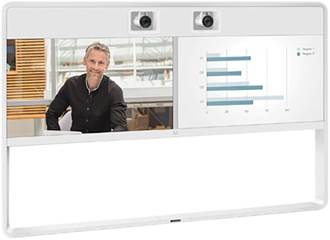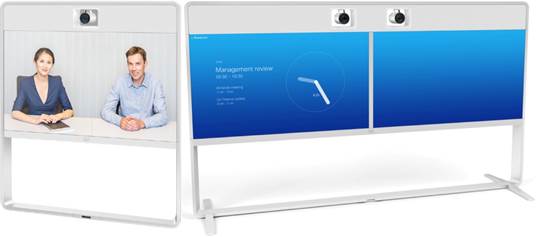Cisco TelePresence MX700 and MX800 represent the performance line within Cisco’s portfolio of integrated video collaboration room systems. They combine beautiful design and powerful functionality into an all-in-one solution for medium-to-large meeting rooms. These multipurpose systems will transform your meeting room into a video collaboration hub – whether for connecting teams across the globe or for local meetings. The MX700 and MX800 feature dual LED monitors for a people-only or people-and-content experience. The MX800 is also available with a single LED monitor for a peopled-focused solution.
Cisco TelePresence MX700 & MX800
- 产品基本信息
- 产品特点与优点
Product Specifications
Table 2 lists the product specifications; Table 3 gives video and audio specifications; Table 4 gives network, security, and management specifications; and Table 5 gives ordering information for the Cisco TelePresence MX700 and MX800.
Table 2. Product Specifications
Product Capabilities
Table 3 lists the product capability specifications for the MX codec.
Table 3. Product Specifications
|
Specification |
Description |
|
Product delivered complete with |
● One mounting option, single or dual camera option (MX800 Dual – is only available with dual camera), Cisco Touch 10, MX Codec, complete audio system, 2x Cisco Mic 60, 2 presentation cables
|
|
Bandwidth |
● H.323/SIP up to 10 Mbps point-to-point
● Up to 10 Mbps total MultiSite bandwidth
|
|
Minimum bandwidth for resolution/frame rate (H.264) |
● 720p30 from 768 kbps
● 720p60 from 1152 kbps
● 1080p30 from 1472 kbps
● 1080p60 from 2560 kbps
|
|
Firewall traversal |
● Cisco Expressway technology
● H.460.18 and H.460.19 firewall traversal
|
|
Video standards |
● H.261, H.263, H.263+, H.264 and H.265 (SIP only for H.265)
|
|
Video features |
● Advanced screen layouts
● Custom video layouts
● Local auto layout
|
|
Video inputs |
Three HDMI Inputs; supported formats: ● 1920 x 1080@60 and 59.94 Hz (1080p60)
● 1920 x 1080@50 Hz (1080p50)
● 1920 x 1080@30 and 29.97 Hz (1080p30)
● 1920 x 1080@25 Hz (1080p25)
● 1920 x 1080@24, and 23.97 Hz (1080p24)
● 1280 x 720@60, and 59.94 Hz (720p60)
● 1280 x 720@50 Hz (720p50)
● 720 x 480@60, and 59.94 Hz (480p60)
● 640 x 480@60 Hz (480p60)
● 1280 x 1024@60, and 75 Hz (SXGA)
● 1024 x 768@60, 70, 75, and 85 Hz (XGA)
● 800 x 600@56, 60, 72, 75, and 85 Hz (SVGA)
● 1680 x 1050@60 Hz (WSXGA+)
● 1440 X 900@60 Hz (WXGA+)
● 1280 x 768@60 Hz (WXGA)
● 1920 x 1200@60 Hz (WUXGA)2
● 1920 x 1200@50 Hz (WUXGA)2
One DVI-I Input; supported formats: Analog (VGA): ● 1920 x 1080@60 Hz (1080p)
● 1280 x 720@60 Hz (720p)
● 1280 x 1024@60 and 75 Hz (SXGA)
● 1280 x 960@60 Hz
● 1024 x 768@60, 70, 75, and 85 Hz (XGA)
● 1680 x 1050@60 Hz (WSXGA+)
● 1440 x 900@60 Hz (WXGA+)
● 1280 x 800@60 Hz (WXGA)
● 1280 x 768@60 Hz (WXGA)
Digital (DVI-D): ● 1920 x 1080@60, 59.94 Hz (1080p60)
● 1920 x 1080@50 Hz (1080p50)
● 1920 x 1080@30, 29.97 Hz (1080p30)
● 1920 x 1080@25 Hz (1080p25)
● 1920 x 1080@24, 23.97 Hz (1080p24)
● 1280 x 720@60, 59.94 Hz (720p60)
● 1280 x 720@50 Hz (720p50)
● 720 x 480@60, 59.94 Hz (480p60)
● 640 x 480@60 Hz (480p60)
● 1280 x 1024@60, 75 Hz (SXGA)
● 1024 x 768@60, 70, 75, 85 Hz (XGA)
● 800 x 600@56, 60, 72, 75, 85 Hz (SVGA)
● 1680 x 1050@60 Hz (WSXGA+)
● 1440 X 900@60 Hz (WXGA+)
● 1280 x 768@60 Hz (WXGA)
● 1920 x 1200@60 Hz (WUXGA)2
● 1920 x 1200@50 Hz (WUXGA)2
One Composite/S-video Input (BNC Connectors) ● PAL/NTSC
HDMI input 1 is used for Main Camera (included in base package) HDMI input 2 is used in addition if Speaker Track Option (2ndcamera) is installed Extended Display Identification Data (EDID) |
|
Video outputs |
Two HDMI Outputs and one DVI-I Output; supported formats: ● 1920 x 1080@60 Hz (1080p60)
● 1920 x 1080@50 Hz (1080p50)
● 1280 x 720@60 Hz (720p60)
● 1280 x 720@50 Hz (720p50)
● 1920 x 1200@60 Hz (WUXGA)2
● 1920 x 1200@50 Hz (WUXGA)2
MX700: HDMI output 1 & 2 are in use with the 2 screens MX800: HDMI output 1 is in use with the screen VESA Monitor Power Management Extended Display Identification Data (EDID) |
|
Live video resolutions (encode and decode) |
● 176 x 144@30 frames per second (fps) (QCIF)
● 352 x 288@30 fps (CIF)
● 512 x 288@30 fps (w288p)
● 576 x 448@30 fps (448p)
● 768 x 448@30 fps (w448p)
● 704 x 576@30 fps (4CIF)
● 1024 x 576@30 fps (w576p)
● 1280 x 720@30 fps (720p30)
● 1920 x 1080@30 fps (1080p30)
● 1920 x 1200@15fps (WUXGA)2
● 640 x 480@30 fps (VGA)
● 800 x 600@30 fps (SVGA)
● 1024 x 768@30 fps (XGA)
● 1280 x 1024@30 fps (SXGA)
● 1280 x 768@30 fps (WXGA)
● 1440 x 900@30 fps (WXGA+)
● 1680 x 1050@30 fps (WSXGA+)
● 512 x 288@60 fps (w288p60)
● 768 x 448@60 fps (w448p60)
● 1024 x 576@60 fps (w576p60)
● 1280 x 720@60 fps (720p60)
● 1920 x 1080@60 fps (1080p60)
|
|
Audio standards |
● G.711, G.722, G.722.1, G.728, G.729AB, 64 kbps and 128 kbps MPEG4 AAC-LD mono and stereo, OPUS
|
|
Audio features |
● CD-quality 20 kHz mono and stereo
● Eight separate acoustic echo cancellers
● Eight-port audio mixer
● Automatic Gain Control (AGC)
● Automatic noise reduction
● Active lip synchronization
|
|
Audio inputs |
● Eight microphones, 48V phantom powered, Euroblock connector, each with separate echo cancellers and noise reduction; all microphones can be set for balanced line level (2 Microphones included in base package)
● Four balanced line level inputs, Euroblock connector (one balanced line level input used when VGA-DVI presentation cable is used)
● Three HDMI, digital: stereo PC/DVD input (one HDMI audio input used when HDMI-HDMI presentation cable is used)
|
|
Audio outputs |
● Six balanced line level outputs, Euroblock connector
● Two HDMI outputs (MX700: Both HDMI audio outputs are used for the 2 screens. MX800: One HDMI audio output is used for the screen)
|
|
Dual stream |
● H.239 (H.323) dual stream
● BFCP (SIP) dual stream
● Support for resolutions up to 1080p30/WUXGA, and independent of main stream resolution
|
|
Multipoint support |
● Five way embedded SIP/H.323 multipoint (reference MultiSite, available as an option)
● Cisco ad-hoc conferencing (requires CUCM, Cisco TelePresence Server and Conductor)
● Cisco Conferencing Active Control
● Switched conferencing (SVC)2
|
|
MultiSite features |
● Five way 720p30 High Definition, three or four way 1080p30
● Full individual audio and video transcoding
● Individual layouts in MultiSite continuous presence
● H.323/SIP/VoIP in the same conference
● Support for Presentation (H.239/BFCP) from any participant at resolutions up to 1080p15
● H.264, encryption, and dual stream from any site
● Additional telephone call (no license required)
● IP downspeeding
● Dial in and dial out
● Conference rates up to 10 Mbps
|
|
Protocols |
● H.323
● SIP
● Dual call stack support, H323 and SIP registration
● ISDN (requires Cisco TelePresence ISDN Link)
|
|
Embedded encryption |
● H.323/SIP point-to-point and MultiSite
● Standards-based: H.235 v3 and Advanced Encryption Standard (AES)
● Automatic key generation and exchange
● Supported in dual stream
|
|
IP network features |
● DNS lookup for service configuration
● Differentiated Services (QoS)
● IP adaptive bandwidth management (including flow control)
● Auto gatekeeper discovery
● Dynamic playout and lip-sync buffering
● H.245 DTMF tones in H.323
● Date and Time support via NTP
● Packet Loss based downspeeding
● URI Dialing
● TCP/IP
● DHCP
● 802.1x Network authentication
● 802.1Q Virtual LAN
● 802.1p (QoS and class of service [CoS])
● ClearPath
|
|
Cisco Unified Communications Manager (requires Cisco Unified Communications Manager Version 8.6 or later) |
● Native registration with Cisco Unified Communications Manager
● Basic Cisco Unified Communication Manager provisioning
● Firmware upgrade from Cisco Unified Communications Manager
● Cisco Discovery Protocol and DHCP option 150 support
● Basic telephony features such as hold, resume, transfer, and corporate directory lookup
|
|
IPv6 network support |
● Dual-stack IPv4 and IPv6 for DHCP, Secure Shell (SSH), HTTP, Secure HTTP (HTTPS), DNS, and Differentiated Services (DiffServ)
● Support for both static and autoconfiguration (stateless address auto configuration)
|
|
Security features |
● Management through HTTPS and SSH
● IP administration password
● Menu administration password
● Disable IP services
● Network settings protection
|
|
Network interfaces |
● One LAN/Ethernet (RJ-45) 10/100/1000 Mbit
● Two LAN/Ethernet (RJ-45) interfaces to be used for Cisco TelePresence Peripherals
|
|
Other interfaces |
● Two USB host for future usage
● GPIO
|
Product Features
Table 1 summarizes the key features for the MX700 and MX800 systems.
Table 1. Feature Summary
|
Feature Summary |
|
|
Design features |
● One of the most powerful and feature-rich video systems available with the ultimate in video and audio quality
● The next generation HD video collaboration codec
● The next generation HD PTZ camera
● Everything you need in one unit (Screens, speakers, codec, camera, User Interface, Microphones, mounting)
● Wallmount or Floorstand (2 Floorstand options included: Freestand and wall secured floorstand)
● Industry first built-in speaker tracking system as option
|
|
Application features |
● Supports Cisco Intelligent Proximity for content sharing to mobile devices and wireless sharing from Macs and PCs2
● Supports Switched Conferencing (SVC) for enhanced layouts and enabling video on both screens of dual screen endpoints2
● Easily control room peripherals such as lights, room dividers, curtains, directly from the Cisco TelePresence Touch 10 through customizable API1 (requires external third-party control system processor)
● 1080p30 HD embedded Cisco TelePresence MultiSite with individual transcoding
● Collaborate with four simultaneous video inputs
● HD collaboration with 1080p60 main and 1080p30 content
● One button to push (OBTP) to start a meeting
● Ideal for team-based collaboration, boardrooms, meeting rooms and video centric rooms
● Dual presentation outside of a call (increase usage of system outside of a call – use the MX700 dual screens to compare 2 presentations/documents)
|
|
Performance features |
● Optimal definition up to 1080p60
● H.323/SIP up to 10 Mbps point-to-point
● Up to 10 Mbps total MultiSite bandwidth
● Ability to connect up to four HD sources and 8 microphones directly to the codec
● Full duplex audio with high-quality stereo sound
● Full application programming interface (APIs)
● Ability to take advantage of Cisco TelePresence Total Solution Management, transcoded HD MultiSite, recording and streaming, Ad-hoc Conferencing, and firewall traversal
● Cisco TelePresence ClearPath packet loss protection technology for optimal experience
● Cisco Unified Communications Manager native support (requires Cisco Unified Communications Manager version 8.6 or higher)
|




